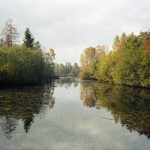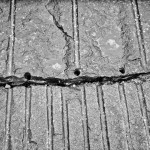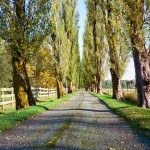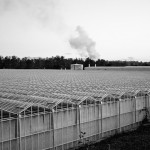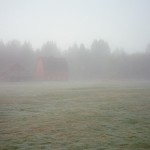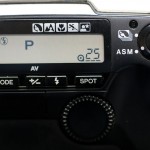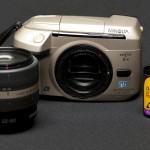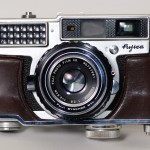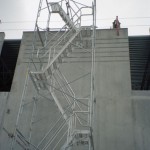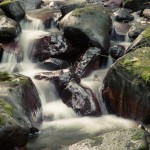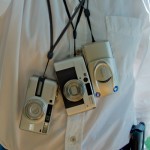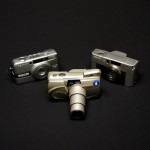Dec
30
2011
While watching a documentary on Fred Herzog Snapshot: The art of Photography II, a Vancouver photographer best known for his Kodachrome slides of the city during the 1950’s and ’60s, I was struck by his use of the Canon WP-1 while being interviewed on the street. It got me to wonder why he would be using a 15 year old point and shoot camera. Never having met him I clearly have not asked why but here are my reasons that he might choose this camera despite all the other options available. These are not in any particular order but as they come to mind.
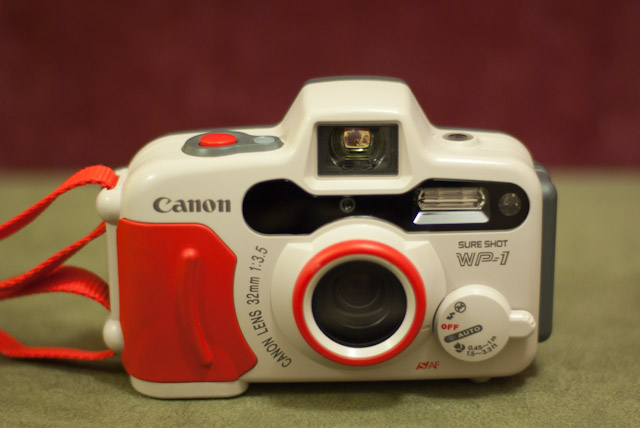
1. It is weather proof (this can be an important thing in Vancouver at some times of year)
2. It has an large viewfinder with a 33mm eye-point in fact you can compose pictures with out even bring it right to your eye.
3. It has a simple control dial on the front that does all the functions in a simple arrangement (Flash Off,Flash On, OFF, Auto, Macro) the only buttons are shutter and timer
4. It is quiet, the shutter and film advance are on the quiet side for a point and shoot film camera likely going unnoticed on the street.
5. The Lens is 32mm which is wide but not too wide
6. Here I may be stretching things but because of its construction the lens is completely internal allowing you to put the camera right up against glass.
That seems like plenty of reasons to me. So with some new found interest in retrying this camera I loaded it with some film (I will refer back to this in a moment) and went out and shot a roll of 24. And the result is that despite it’s toy like and slightly ugly appearance it functions well as a wide angle street camera with little fuss. Now as to the film, unfortunately I shot what was film in name only. I need to find any other rolls of this stuff and do an analogue delete on it. I think I’m cured, for now, from my pentient for shooting with anything I find or am given.
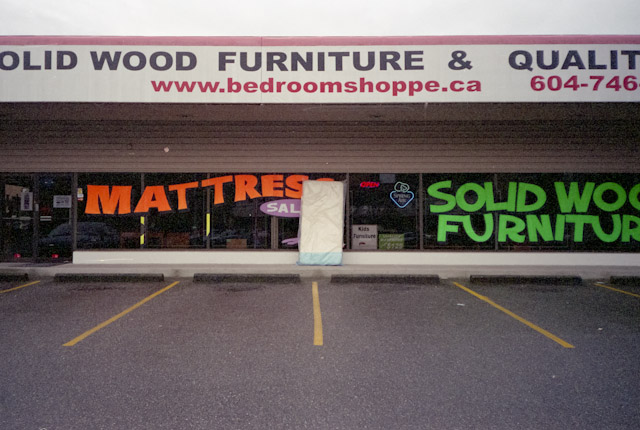

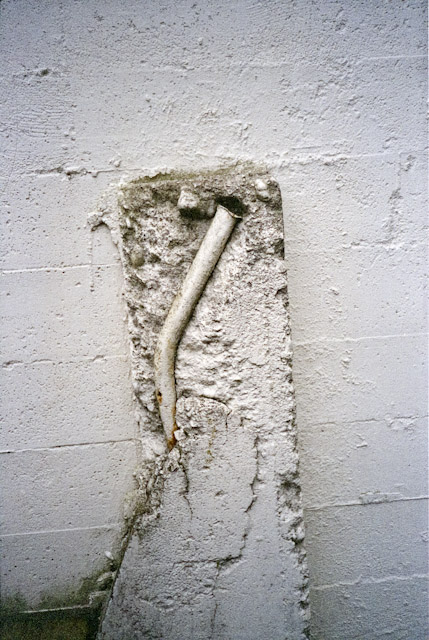
2 comments | tags: Canon, film, WP-1 | posted in Cameras, Photography
Dec
21
2011

Something happened along the way to this blog post. I had originally intended to show the difference in output from these two cameras using their respective film formats (35mm for the Big Mini and APS for the Super Big Mini) but the thing is that it really is indisputable that 35mm film is better so I decided to just throw all of the shots together and forget about it. Several things are apparent however. The wide aspect of the APS film can be used to make an interesting difference in some compositions, it amounts to 16:9 when you use the entire frame and the other thing is that the Super Big Mini has quite a bit of vignetting with the larger 35mm film.

Big Mini and Super Big Mini (which is actually a double oxymoron)
6 comments | tags: 35mm, APS, film, Konica, mini | posted in Cameras, Photography
Dec
19
2011
Back in olden times, when surfing the Internet was preceded by the squelch of a phone modem and required you to know the URL of the sight you wanted to go to, film manufacturers decided to make things more convenient. Not for the Internet, they didn’t see that coming, but for handling film. What they came up with was APS film and what it addressed was the loading and storage of the film. The film stayed inside the cartridge completely until loaded by the camera and was stored inside the cartridge again after being developed. People using APS film never actually saw the film itself. In creating the cartridge though they did one other significant thing and that was reduce the film size as compared to 35mm film which was and is the film size that most people are familiar with. The side effect of this reduced size is also a lowering of picture quality, especially evident when the images are enlarged beyond a certain size. Because most of these pictures where never printed larger than 5″x7″ this largely goes unnoticed.
Fast forward several years and we are now searching the Internet more effectively but not yet Googling. At this point digital photography’s is skyrocketing and film use is plummeting. APS film being the weaker of the film formats with a much smaller user base was the first to be left behind. A lot is happening within digital photography at this time, point and shoot cameras actually suck and produce inferior images and cost large sums of money. Digital SLR’s are only just becoming available and also cost large sums of money. Most DSLR’s then as now came out with either a sensor the same size as 35mm film often referred to as “full frame” or the smaller APS-c or “cropped sensor”. Why would manufacturers even bother with producing sensors the same size as the failed APS film you might ask. The reasons are mostly down to the cost of manufacturing the sensors and as it turns out the full frame ones are a lot more costly relative to there size. So in order to create a market for DSLR’s camera makers needed to bring the costs down to a point that enough people could afford them, how else could they sell lenses. I remember it was a big deal when the first sub $1000 DSLR was released in around 2006.
From day one it was clear that full frame sensors were better than APS-c ones as it had been between the two film sizes. Manufactures helped to make this clear also by putting full frame sensors in their big rugged professional cameras and APS-c sensors in their consumer offerings. And that is how it’s been for about ten years, but the thing is that sensors have been steadily improving with each new iteration and the gap in image quality between full frame and APS-c has narrowed. This may be as much a result of companies putting resources to where they feel they will get the best return. After all they are not out to produce the best camera with no concern for cost they are competing hard to stay ahead of each other in the market place. There are many more things going on in digital photography including other sensor sizes and camera forms but within the DSLR world it’s mostly about full frame and crop sensors.
So if full frame sensors result in better image quality in general then what if any advantage other than cost do crop sensors provide? Well because of there smaller size they record a narrower field of view from the same focal length lens. This is often referred to as the crop factor. This “crop factor” is roughly 1.5 times for most APS-c sensors. The result is that for example a 100mm lens on APS-c provides the same field of view as a 150mm lens on full frame. This relationship is true for any focal length so that a 300mm lens becomes equivalent to a 450mm lens on full frame. In this case it’s clearly an advantage for people wanting a long telephoto lens. The opposite is true for wide angle where what was a wide 18mm becomes equivalent to a 28mm lens on a full frame camera.
So why did I title this post revenge of APS? Well it’s been a long road but we are at a point where some of the most recent APS-c sensors can perform at the same level as full frame sensors. This may not be a universally held belief but it’s pretty easy to argue that the difference isn’t nearly what it once was. It’s true that “full frame” cameras provide a shallower depth of field, but may not be the be all end all of photography. I find myself again on the side of the argument that ends with the question. If the viewer of an image has no idea how it was made does it matter how it was made?
In a future post I will time travel back to 1996 and compare two otherwise similar cameras having the key difference that one took 35mm film and the other APS.

5 comments | tags: APS, Cameras, film, Full Frame | posted in Cameras, Photography, Uncategorized
Nov
26
2011
Well Polaroid a week has slipped to something closer to Polaroid a month but as long as I still have some left I will press on. The scarcity of original Polaroids compels me to post the images no matter how they turn out. So here is my latest one with it’s mysterious defocusness (it’s my blog I can make up words if I want).

And this is what I saw with my Cell phone.
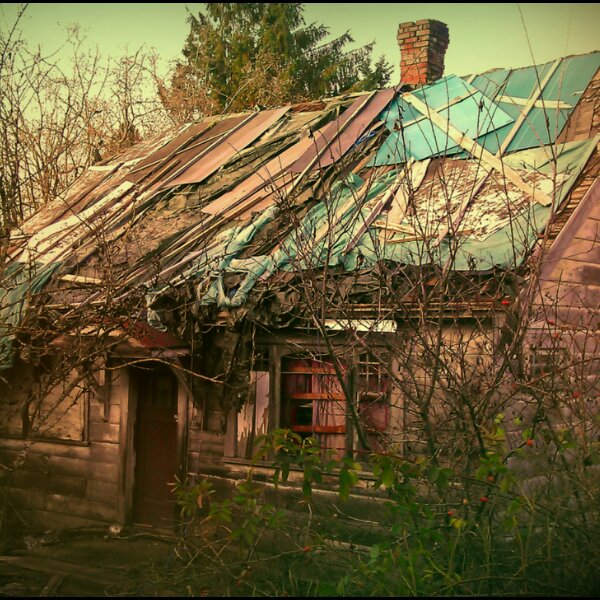
no comments | tags: film, Photography, polaroid | posted in Photography, Processing
Nov
18
2011

What can one really say about a camera that was a dead end and used a dead end film. Why even bother with this blip in the history of photographic equipment? What possible relevance could this have to today? Nope I can’t come up with a reason either but if I don’t who else is. The Minolta Vectis S-1 is an SLR with interchangeable lenses that used APS film. APS film was, yes I’m using past tense despite the fact that you can still buy it at this time, a smaller film than the more common 35mm. APS film became available in 1996 but never stood a chance as we stood on the verge of the digital photography revolution that would eventually take over from most film formats. It’s main claim was convenience and not quality as it had a film area that was only about 55% of a 35mm negative. That smaller size does live on in the form of most consumer DSLR’s and is referred to as APS-C which was also one of the aspect ratio’s available with the film.
What the Minolta Vectis S-1 offered was a small SLR with all the controls you would expect plus weather sealing. Despite it’s dead end status it does appear that some early DSLRs, such as the Olympus E-300, took design elements from it only a few years later.
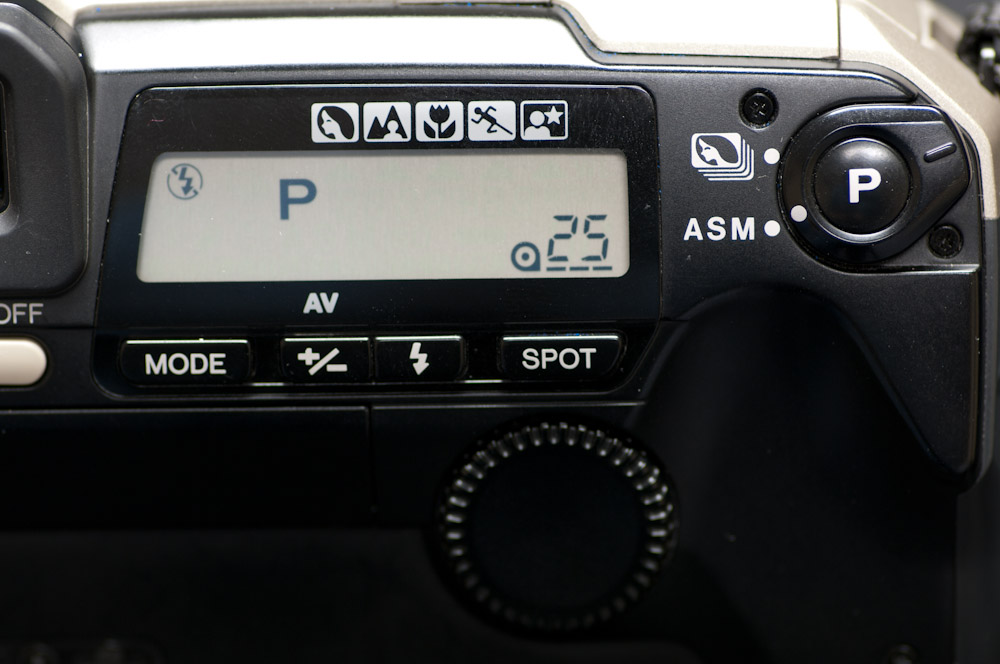
You can see from this shot of the rear controls that the camera afforded such things as aperture and shutter priority as well as exposure compensation. The ergonomics are very good on this camera and it’s size allows for easy carrying something I value today with smaller digital cameras as apposed to some current DSLR’s that seem to equate physical size to capability. All this is irrelevant of course because it’s not really a camera you would want to use when so much better image quality is available so much cheaper through digital cameras.
All that said here are some images I shot using the Minolta Vectis S-1.
2 comments | tags: APS, film, Minolta | posted in Cameras, Photography
Nov
16
2011
Only computer monitors appear to be more of an attractant to dust than film. If there is any static charge on the film dust will stick to it like glue. So I recommend Acme brand (If Acme exists I don’t think they actually make Anti-static brushes but you can Google it if you want). In any case I use an anti-static brush which dramatically improves the effectiveness of any air blower. I also have another one that I use for removing dust from the front element of lenses, this is often enough as the less contact you have with a lens element the better in my opinion. Another thing that I use to reduce the dust in the area where my scanner is, is an electrostatic air cleaner which uses the static charges it develops to pick dust out of the air as it passes through. It’s not easy keeping dust out of your scans but it’s effort that you don’t have to spend later in post processing.

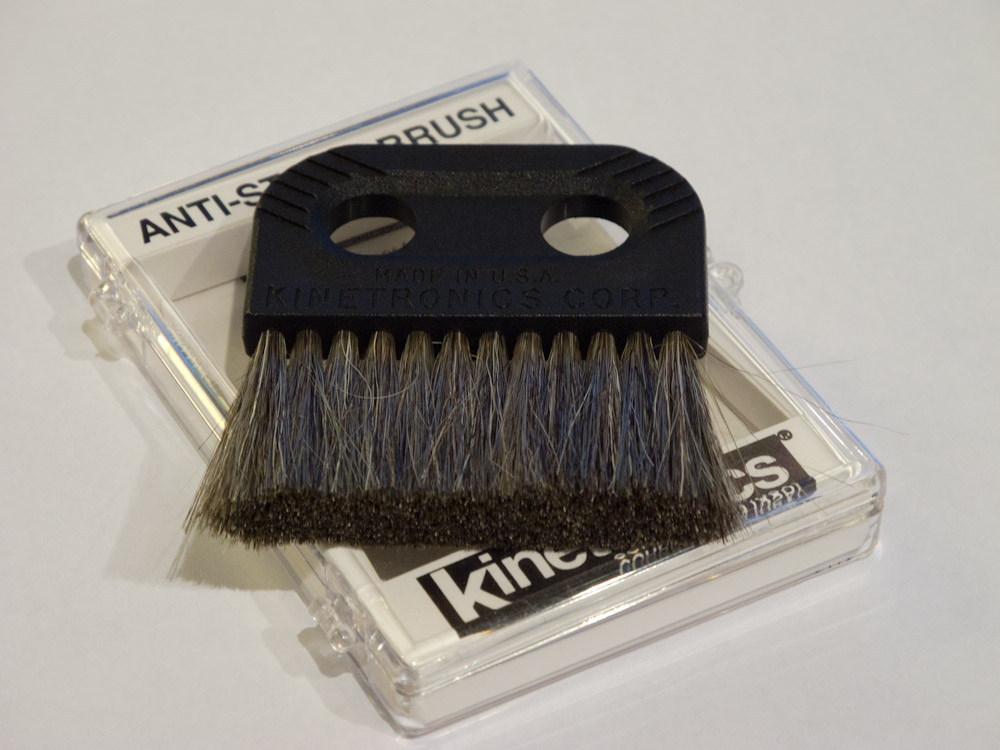
2 comments | tags: film, scanning, static | posted in Cameras, Photography
Oct
30
2011
Some random shots from my Fujica 35SE. I’ve been thinking about Fuji lately as their new camera the X10 will become available soon. I’m looking forward to having a look at one but for now I thought use what you have.

no comments | tags: film, Fuji, Fujica | posted in Cameras, Photography
Oct
17
2011
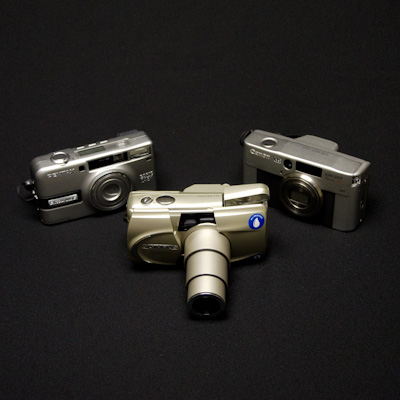
As the Canon Classic and the Pentax 24EW (pronounced 2-4-EEEEEeeeewwwww) fought it out to be the supreme irrelevant the Olympus mju III was waiting for it’s moment. In a move reminiscent of Doc Brown it has vualted forward from 2003 and staked it’s claim to be the preeminent irrelevant camera from around the turn of the last century. It’s 37.5-150mm (really 1/2 a mm wider you coun’t have rounded?) lens is something to behold. That’s 150mm in a Point and shoot! I’m not aware of any PS film cameras that had a longer lens.
So why wouldn’t it just win hands down, it’s lens is the longest? The reason is that it lacks much of the control that the Pentax and Canon have such as exposure compensation and that neat feature of automatic zoom for portraits. Features like that really help when your trying to be the best of the abandoned. And the Olympus is champagne coloured, please that is so 2000. The Canon and the Pentax are a “real” camera colour silver, which isn’t really a colour because it’s just a reflection…..
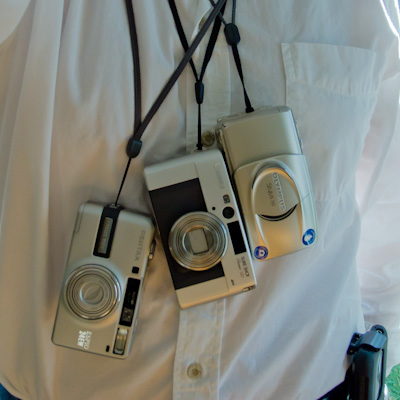 So how did it perform? It took some getting used to because it seemed to want to use the flash all the time every time. This was annoying and required me to poke at teeny little buttons until the flash symbol was off every time I turned the camera on (camera on-flash off-camera off-flash on-camera on-flash off) I think you get the idea. The one feature it has and luckily is useful is the spot metering.
So how did it perform? It took some getting used to because it seemed to want to use the flash all the time every time. This was annoying and required me to poke at teeny little buttons until the flash symbol was off every time I turned the camera on (camera on-flash off-camera off-flash on-camera on-flash off) I think you get the idea. The one feature it has and luckily is useful is the spot metering.
The results though were good, again if good had stayed the same since 2003 but good is better now than it was then, (flash-off) After all this which one would I choose you might ask if you cared. The thing is they all have a certain charm. The Pentax for it’s control and 24mm wide lens, the Canon for it’s looks and image quality and the Olympus for it’s 150mm long lens. If you thought choosing a camera a decade ago was hard it’s far worse now. There are more categories of cameras and more cameras in each category and new one replace old ones at a rate that even the all mighty internet can’t keep up with.
I hope you’ve enjoyed this little blast from the resent past, and take a moment to reflect just how much has changed between 2003 and 2013 (note if it isn’t 2013 when you read this ignore that)
1 comment | tags: Cameras, film, olympus | posted in Cameras, Photography
Oct
3
2011
If you’ve been waiting to find out which point and shoot camera you should have bought ten years ago, your prolonged wait is over. PreviouslyI posted about the Canon Sure Shot Classic and the Pentax 24EW and now that I have the film back and scanned I was able to make a results comparison. Well the Pentax wins hands down from 24 to 38mm but considering the Canon starts at 38mm that isn’t praise. In almost ever picture under the same conditions the Canon produced a better result, both through exposure and image quality. As I used the same sensor (Kodak 400) it really did come down to the cameras. Here are some of the shots in a side by side. If it’s wide you want though the Pentax is the one.

Above you can see the Pentax can get a little closer for a zoomed macro and bellow the difference between 24 and 38mm is pretty clear.

This crop shows both cameras at there maximum zoom 120mm (Canon) vs 105mm (Pentax)

This detail crop really shows the difference. In all these pictures I’ve made no effort to deal with the grain of the film or optimize the images beyond trying to scan them accurately.
This just in Olympus has joined the conflict with the mju III 150 (circa 2003) with it’s 8 element ED 37.5mm to 150mm lens, stunning the competition, and again causing the Pentax to faint.

4 comments | tags: Cameras, Canon, film, Pentax | posted in Cameras, Photography
Sep
22
2011
Small is beautiful as far as I’m concerned when it comes to cameras. Here are some frames from my Olympus XA which is the smallest true rangefinder that I own. I wish that I could design my own camera free of any concerns about money or infinging on copyright or purhaps the laws of physics. It would end up being pretty small and not necesarily have a lot of features beyond easy controls, something like a digital Olympus XA maybe?

Here is the XA nestled next to the Pentax K10D with grip, which wouldn’t be confused for a small camera, unless you were a gaint.
no comments | tags: film, olympus, Xa | posted in Cameras, Photography





